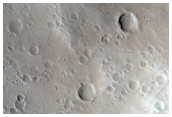3
3488
Guest
Below copied EarthlingX post from the ESA MArs Express thread in M & L.
http://www.esa.int : Mars’s mysterious elongated crater
Above courtesy of EarthlingX
I thought this was worthy of it's own thread on here.
Thanks EarthlingX,
Very, very interesting. An elongated crater that to me looks lava filled, perhaps a glancing impact, which filled with lava???.
I'll submit a request to the MRO HiRISE team to get a really hires view of the interior, to see the density of smaller impact craters & / or erosional evidence to help ascertain it's age.
Similar curious elongated craters of similar ilk to Orcus Patera have also been found on Mercury & the Moon.
220 Km by 120 KM Sveinsdottir Crater on Mercury.


179 KM by 71 KM Schiller Crater on the Moon.

380 KM by 140 KM Orcus Patera on Mars.

Below also a copy of post from EarthlingX.
There is a similar elongated crater on the left top rim, but much smaller.
 I was checking available images of the area, but none of those i found covers the whole feature, or at least not as detailed as we got spoiled by the HiRISE
I was checking available images of the area, but none of those i found covers the whole feature, or at least not as detailed as we got spoiled by the HiRISE 
There are at least two images, but they are covering the rim and not the interior, and only half of the whole thing.
Andrew Brown & EarthlingX.
http://www.esa.int : Mars’s mysterious elongated crater
27 August 2010
Orcus Patera on Mars
Orcus Patera is an enigmatic elliptical depression near Mars’s equator, in the eastern hemisphere of the planet. Located between the volcanoes of Elysium Mons and Olympus Mons, its formation remains a mystery.
Often overlooked, this well-defined depression extends approximately 380 km by 140 km in a NNE–SSW direction. It has a rim that rises up to 1800 m above the surrounding plains, while the floor of the depression lies 400–600 m below the surroundings.
Above courtesy of EarthlingX
I thought this was worthy of it's own thread on here.
Thanks EarthlingX,
Very, very interesting. An elongated crater that to me looks lava filled, perhaps a glancing impact, which filled with lava???.
I'll submit a request to the MRO HiRISE team to get a really hires view of the interior, to see the density of smaller impact craters & / or erosional evidence to help ascertain it's age.
Similar curious elongated craters of similar ilk to Orcus Patera have also been found on Mercury & the Moon.
220 Km by 120 KM Sveinsdottir Crater on Mercury.


179 KM by 71 KM Schiller Crater on the Moon.

380 KM by 140 KM Orcus Patera on Mars.

Below also a copy of post from EarthlingX.
It could be lava filled, but could also be filled with water sediments or wind. My first impression was a glancing multi-body impact (3-4). It looks rather young, but obviously older than those crossing 'graben' or fissures, or perhaps interior got filled later ?3488":ya2iscei said:Thanks EarthlingX,
Very, very interesting. An elongated crater that to me looks lava filled, perhaps a glancing impact, which filled with lava???.
There is a similar elongated crater on the left top rim, but much smaller.
Very nice3488":ya2iscei said:I'll submit a request to the MRO HiRISE team to get a really hires view of the interior, to see the density of smaller impact craters & / or erosional evidence to help ascertain it's age.
There are at least two images, but they are covering the rim and not the interior, and only half of the whole thing.
Andrew Brown & EarthlingX.
























